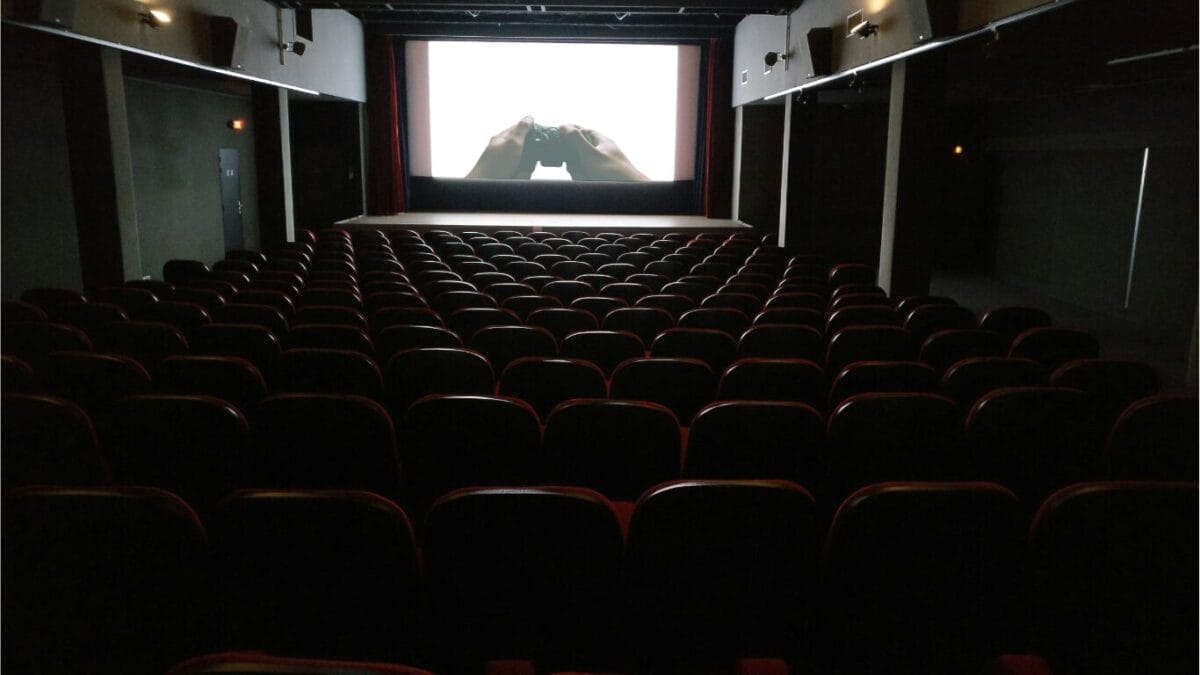By Anna C. Webster
I spent a lot of time in basements as a kid.
Where I grew up, many homes were built into the side of a hill due to the lack of level ground, so they often had basements that opened up into the back yard. One such basement contained my childhood bedroom. But another, arguably one that shaped who I would become even more so, was the basement where our local community theater group rehearsed.
Maryanne’s basement was magical. Not because it was expertly decorated or even particularly lavish, but because of where it could take you. That basement quickly fell away once rehearsal started, and suddenly you were in Neverland, or Narnia, or interwar Austria. I started acting at age 8, and I truly believe it’s what would ultimately lead me to go on to write video games (possibly more than my English degree).
If you know me, you’ve likely already heard my soapbox about the similarities between theater and games. Theater has fewer degrees of separation from video games than even film or television. There are the more obvious parallels: roles within a theater company mirror that of a dev team. There are actors, directors, lighting artists, set designers/level designers, costume workers/tech artists, and engineers. Everyone works together from their respective disciplines to tell the many facets of a story. And while you could argue that film and television do similar things, theater and games are closer kin because of their unique relationship between the media itself and its viewer.
Theater is an art form wherein the viewer has undertaken an unspoken social contract. There are certain theoretical conventions that the audience has opted into (or rather, out of) when they have taken their seats in the house and the lights begin to dim. The components of this social contract are vast and varied, but there’s one critical concept that theater and games use like none other.
Suspension of Disbelief
“Suspension of Disbelief” as coined by English philosopher and writer Samuel Coleridge, is the intentional disengagement with traditional skepticism and rationality. For example: accepting that magic is an inherent and normal part of the world within a specific work is the byproduct of suspension of disbelief. You intentionally disregard that magic isn’t real in the “real world,” and instead willingly engage with the story with the complete illogical understanding that in this world, it is.
Humans come by this ability naturally due to our unique capacity for imagination. Coleridge notes that the practice of suspension likely originated with Greco-Roman theatrical principles, but its origins are likely much earlier in ancient storytelling traditions. In fact, suspension of disbelief occurs when engaging with almost any work of fiction, irrespective of genre or medium.
In the performing arts, suspension of disbelief goes beyond throwing logic to the wind and accepting magic with open arms. It extends outward to the audience themselves in a way that television or film doesn’t ask of its viewer. In recorded, non-interactive media, the viewer understands that they are witnessing something that has already happened: it has already been recorded, edited, mixed, and distributed to them either in a movie theater or streamed to a home device. With theater, however, you are under the impression that you are watching events unfold in real time and in the real space where they occurred.
These specific applications of suspension of disbelief are referred to in the dramaturgy world as “illusions.” However, there’s no rabbit being pulled out of a hat: illusions become illusions when the audience enters that social contract, and we can consider them the critical supports upon which suspension of disbelief is, well, suspended.
Illusion of Place
The “illusion of place” refers to the audience intentionally allowing themselves to understand that the stage is not just some raised platform in an auditorium downtown. Instead, what you are seeing is occurring somewhere else entirely. This illusion renders the stage not merely representative of a space, it becomes the space as the concept of representation is abandoned alongside disbelief. Obviously, embellishments like sets, lighting, and some well-placed fog never hurt when it comes to convincing the audience of this, but the illusion is present even in the most simple of places: like a basement in the mountains or a traditional “black box” theater.
Games experience the illusion of place, too. When you press launch, you’re no longer sitting at your desk or a couch or a lawn chair parked in front of a TV like countless setups on r/malelivingspaces. Though what you’re looking at are nothing more than colored pixels on a screen or models rendered in an engine, you forgo the concept of representation: you’re in the Vvardenfell district of Morrowind, or Night City, or Kamurocho, now – and these places are where the events occur, not some fictionalized locale. With the suspension of disbelief and illusion of place, the audience understands that they have been transported to a real location and time, regardless of how “real” it truly is.
Illusion of the First Time
The “illusion of the first time” is twofold: the audience disengages with the reality that what they’re about to witness is a rehearsed production, and the actors behave as though they haven’t rehearsed this exact show a billion times before. This experience is spontaneous and entirely new to the audience, actors, and characters within the story itself.
In the theater world, this is helped by the wide variety of ways a show might vary from production to production or director to director. Fresh interpretations of the same story really help things feel new and potentially highlight nuances that hadn’t been there previously. For example, I loved the version of Mozart’s Cosi Fan Tutte performed by the Metropolitan Opera where it was set at a motel near Coney Island in the 1950s rather than in 18th century Naples. Even within the run of a singular production, actors are often constantly refreshing and reimagining their own interpretations of their characters and story: from varying line delivery, to experimenting with the emotional resonance of a particular moment or scene. This helps keep things fresh for them, keeps them honing their skills, and also helps perpetuate the illusion that this experience is new to the character.
Games have a similar application of this illusion: whether you’re doing a different run or build in a roguelike or RPG, or playing a remake of a classic title made decades ago. The understanding that this experience is fresh to the characters living it (regardless of how many times you, the player, may have played it previously) remains intact. With the suspension of disbelief and the illusion of the first time, the audience understands that what they are seeing has never happened before.
The games industry has seen several film and television adaptations as of late, and it always seems to be a coinflip regarding the reception and faithfulness of the result. Being “cousin” media formats, there are many pitfalls that film and television have to navigate. For example: interactivity and potentially world-breaking mechanics are hard to convey when the audience isn’t an involved party in the story that’s unfolding before them.
But what happens when there’s overlap of media formats that aren’t cousins – they’re more like brothers. What happens when a game is adapted not into a flashy HBO or Amazon Prime series… but a play?
Stage adaptations of video games are somewhat uncommon, however when they do occur it’s a safe bet that it will happen in Japan. Japan’s historically rich culture surrounding both games and theater makes it a perfect fit for this cross-media jaunt. And they really, really make it work in a way that I’d argue movies and television just can’t match.
Yakuza: The Stage Play
In 2015, as part of the 10th anniversary celebration of the Yakuza (now known as the Like a Dragon) franchise, Japanese theater group Raynet collaborated with Sega to produce a theatrical adaptation of the original Yakuza game, aptly titled: Yakuza: The Stage Play (“Ryu Ga Gotoku Butaiban”). While it only ran for a total of five days in downtown Tokyo, the website for the production is still up and running, and you can find the show in its entirety with English subtitles on YouTube.
For the unfamiliar, the Yakuza/Like a Dragon series follows a triad of protagonists: stoic and chivalrous Kiryu Kazuma, the eccentric yet ruthless Goro Majima, and the loyal and passionate Ichiban Kasuga. The three navigate life on the fringes of the organized crime (yakuza) world of Japan, having a “sometimes” gangster status. The series has been praised by actual members of the yakuza for its accuracy and attention to detail. The IP often grapples with themes of loyalty, obligation, morality, and generally questioning the role of traditional organized crime rings and their associated masculine ideals as Japan becomes an economic and social world power after the boom of the 1980s. And sure there might be some song and dance breaks thrown in there, but that’s not important.
The story of the original Yakuza game follows protagonist Kiryu Kazuma and his “sworn brother” (a formal oath of loyalty), childhood friend Akira Nishikiyama (often just shortened to “Nishiki”). The two grew up together at the Sunflower Orphanage under the watchful eye of Shintaro Kazama, an old-fashioned white-collar criminal who would eventually be their avenue into the world of organized crime.
The inciting event of the story occurs when Nishiki murders a high-ranking member of their yakuza clan, Sohei Dojima. Dojima had abducted Yumi, Kiryu and Nishiki’s mutual childhood friend (and Kiryu’s sweetheart), which made Nishiki spring into action. Having grown up together, the three are fiercely loyal to each other, and not even a boss of their clan was going to get away with hurting one of their own. However, Nishiki is also highly devoted to his sister Yoko, who has lived with chronic illness since their childhood at the orphanage – and it’s hinted she may not have long left. Kiryu on the other hand has no remaining family, so he makes a split-second decision that it’s better for him to take the fall for the murder in order to let his sworn brother spend as much time with his dying sister as he can. Nishiki tries to object, but Kiryu’s already made up his mind, telling Nishiki to take Yumi and make themselves scarce before the police arrive to arrest him for the crime.
After ten long years in prison for the crime he did not commit (and being expelled from the yakuza to boot), Kiryu is released to find that everything is far from how it used to be. Nishiki, seemingly driven by a quest to prove himself and further unhinged by the grief from his sister’s death, has become a cold-blooded mafioso. Yumi has supposedly become afflicted with a strange case of amnesia and vanished from the hospital where she was being treated after her kidnapping and hasn’t been seen since. And then, of course, there’s the clan’s missing ten billion yen that somehow seems connected to… an unsupervised child? The Yakuza/Like a Dragon games are known for having a myriad of story threads that appear completely unrelated, yet somehow seamlessly converge… You didn’t think I was going to spoil it, did you?
By the time of curtain-up on The Stage Play, Yakuza/Like a Dragon had already produced a number of sequels, with the most recent being Yakuza 5 in the year 2012. Yakuza Kiwami, a full remake of the original game, would release just a year after the closure of The Stage Play in 2016, so The Stage Play was a celebratory hype-train debuting right in the thick of it. This meant that there was already a deep understanding of the story, characters, and setting that could be assumed from the audience. With this in mind, director Takahiro Tamura and playwright and experimental filmmaker Takashi Ito were very faithful to the source material… while making a few intentional deviations: showing cameos of characters who would appear in later games in the franchise or making nods to specific themes and plotlines that would be explored in later installments. This creates a brilliant sense of dramatic irony, thus elevating the audience to almost an omniscient, godlike entity watching the cast scramble around.
And the cast. The cast.
Combined with incredible costume, hair, and makeup work, there’s no doubt in any Yakuza-enjoyer’s mind exactly who these characters are meant to be within the story even at a single glance.



Kiryu is in his classic red-and-white oversized getup, Nishiki is in his white suit with his characteristic slicked-back hair, and Haruka in her typical schoolgirl outfit with her white hoodie and red pleated skirt. And even if you were confused or unsure about who someone was (as the Yakuza franchise famously has a ridiculous amount of characters), the stage play even adopted one of the most iconic elements of character introductions: the title cards.
For the unfamiliar, title cards display at the introduction of each character. Typically, the screen goes black and white, displaying only red text detailing the character’s name and their affiliation (if any). The stage play simulates this by darkening the stage save for a single spotlight on the character being introduced, with their information being projected on a skrim in the background. Here, you can see the title card of Akira Nishikiyama in Yakuza Kiwami and The Stage Play. And yes, the iconic sound effect was also used onstage, don’t you worry.


But the title cards are far from the only direct reference to the mechanics of the game in The Stage Play. What this production does especially well is interweave elements of the gameplay into the events of the story, not just creating clever references but further playing with the audience’s suspension of disbelief. Many film and TV adaptations might have reference to in-game material as “easter eggs,” which don’t necessarily feel like they fit in the context of the adaptation. The first example I can think of is the “itchy tasty” reference in Welcome to Raccoon City (2021), the kitschy film adaptation of the first two Resident Evil games. The strange text originally appears in-game as a note scrawled by one of the workers in the Spencer Mansion, but in the adaptation it appears scrawled in blood on a mirror while Claire Redfield (Kaya Scodelairo) looks on in horror and, likely, confusion. This easter egg feels strange and out of place in the world, and is only meant to be an inside joke to those who know the minutiae of the series… and even then it just feels a little cringy. Yet there’s a moment in Yakuza: The Stage Play where Kiryu literally pauses-time mid combat in order to consume a healing drink found throughout the series. But because of theater’s social contract where the audience has already agreed to forgo logic, this moment is humorous and delightful.

There are many moments like this within The Stage Play: from replicating combat moves from the game in onstage choreography, to intricately-mimicked character mannerisms (seriously, the guy who plays Majima really did his homework), to even projecting in-game footage for transitions and backgrounds. I won’t spoil them all, but I do love the NPCs in Kamurocho who appear onstage with an arrow floating above their heads and limited dialogue. Moments such as these help The Stage Play not just feel like an adaptation of the first Yakuza, but a lovesong to both the series and the medium they hail from – and it’s just not something that I’d argue film or television can match.
This is because video games and theater are both inherently absurd. Of course, I mean absurd in the dramaturgy sense: out of step with reality, logic, and realism. Absurdism has always existed in theater as it’s an inherent element of the suspension of disbelief, but it really had its heyday in the 20th century in the aptly named theater of the absurd movement. As a part of the greater postmodernism movement in art and culture, theater of the absurd highlighted how things are strange, may not make sense, and otherwise naturally exist in a state of being illogical. Video games exist in a similar theoretical space: it makes no real sense how a person can edit how strong they are based on a menu, or heal mid-fight by consuming food or potions. And yet, that’s the natural state of things. So bringing these two art forms together like in Yakuza: The Stage Play celebrates them both in their strangeness. Their absurdity isn’t seen as a deterrent for the discerning, highbrow viewer.
Unfortunately, games have had a historical reputation of being a “less serious” art form that may not even be capable of complex storytelling. It’s not uncommon for games as a whole to be deemed a “waste of time,” especially from traditional critics or members of older generations. So throughout the years as games have become more narrative-driven, higher-fidelity, and quite frankly blockbuster-ish, there’s this Nishikiyama-like undercurrent of the form feeling like it needs to prove itself. However, as games have continued to grab the attention and appreciation from the Hollywood types by jumping for big-budget, award-baiting adaptations, its closest analogous art form is routinely ignored. I can’t help but feel that it’s because movies and television are where the prestige and money is: it’s Nishikiyama swearing he’ll bring back the Tojo clan’s ten billion missing yen in order to get ahead. In fact, following the critical acclaim for their Fallout adaptation, Amazon Prime announced that they are making a live-action Yakuza adaptation earlier this summer.
And while I’ll likely be tuning in, I doubt it will have the same charm and love for the art of video games that The Stage Play did. I just don’t expect it to play with the suspension of disbelief and dramatic irony the same way. Maybe I’ll be surprised. But ultimately, because of the differences in their conventions, I think games need to stop Nishikiyama-ing to try to appear legitimate to film buffs. I’d love to see more weird, delightful, and experimental stage adaptations. Because theater and games? They’re brothers. And I suppose, at least in the case of Yakuza: The Stage Play, they’re sworn brothers.
Anna C. Webster (she/her) is an award-winning writer and narrative designer for video games (and sometimes other things). She holds a BA in English from Virginia Commonwealth University, and much of her work draws on her interests in the performing arts, psychology, and the horror genre. You can find her on most socials, including Neopets, as @annacwebs.
Theater photo by Julien Andrieux.
Gaming photo by Glenn Carstens-Peters.
Collage by Matt Wolfbridge. .
Typebar Magazine is an independent media outlet funded entirely by readers like you. We put every cent we make back into the operation and our primary goal is paying our writers more money. This year we were able to increase pay rates from $50 to $75 but we’d love to offer our writers $100 per essay. Please consider supporting us as we try to make that a reality.





